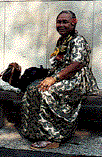|

|
What are
people wearing at the UN in New York?
By Sarah Denham
Walking around the UN, I
see people from many different places; my cultural exposure
has increased since being at this international event. Aside
from the serious issues being discussed at the UN building,
New York is still a city inundated with haute couture, super
models, movie stars and beautiful people. And the question
inevitably arises. "What are people wearing at the
UN?"
|

|
The UN is one place where, since it's an
international event, all cultures are embraced and
welcomed. And truly somewhere where anything goes.
"I live in America. At home and to school I wear
jeans, but at an international event like this one,
I feel comfortable wearing traditional pakistani
clothing," said Rabya Nizam. (Rabya is wearing a
garment called Shalwar Kameez. It's a long tunic
over a long skirt, made of thin, airy fabric.) "The
UN is one place people are comfortable and proud to
show their culture and heritage."
|
|
Indonesian youth delegate Shanthi Sachithanandam
wears a head covering called a "jilbab" (in
Indonesian) or "hijab" (in arabic). She is Muslim
and wears it as part of her religion. "Every Muslim
woman must wear the hijab to cover their hair and
must dress modestly," said Sachithanandam. "It is
believed that after maturity women don't tell the
difference between good and bad and this is for our
protection." She likes to wear her traditional
clothing because she believes that by hiding the
body and hair, men, and even other women won't
judge her for her beauty, but for her mind.
|

|
On the island of Samoa in the South Pacific, tatoos are
considered a form of clothing. Garments are designed around
the tatoos to let their beauty show. Vaasili Moelagi Jackson
wears a "puletasi".
|

|
It's a long wraparound skirt and a separate
tunic made of light material. When she walks, the
skirt brushes aside to reveal the large tattoo on
her leg. The women always wear clothes made out of
flowered material.
"The flowers are a symbol of our rich soil and
celebrate the beautiful colours of our
environment," said Jackson. "Women always wear
flowers behind their ears or in their hair," she
added.
The fresh flowers are more than just decoration.
"A flower behind the left ear is a woman who is
available, behind the right is someone who is
married, or not looking." Her flower is on the left
side. " I like to live dangerously," she laughed.
|
|
One thing Olof Johansson from Saami, Sweden was
not wearing were his shoes! "Saami people are very
in touch with nature and like to celebrate the
earth," he said. He was wearing traditional Saami
clothing. The colours of the clothes and of the
banding around the neck and cuffs, are related to
the colours of the earth, sky and sun. Johansson
was wearing a navy blue tunic and legging-style
pants at the UN, but at home he said that it is
mostlly only the elderly that wear the traditional
garb.
|

|
"The womens' dress is more interesting," he
explained. The colours of their clothes show whether they
are married or looking, replacing the western wedding ring
as an indicator of availability.
|




